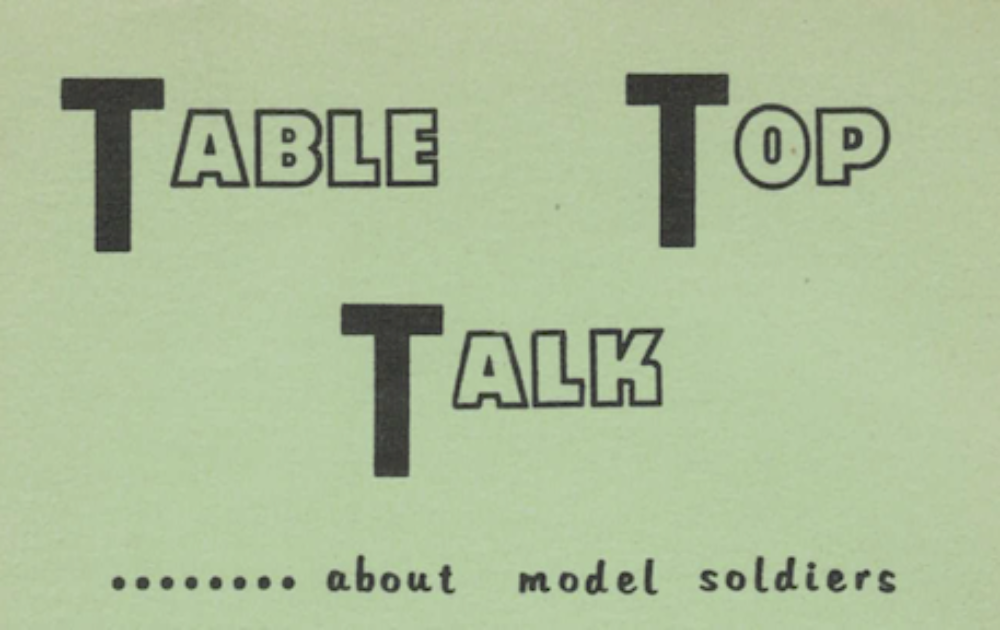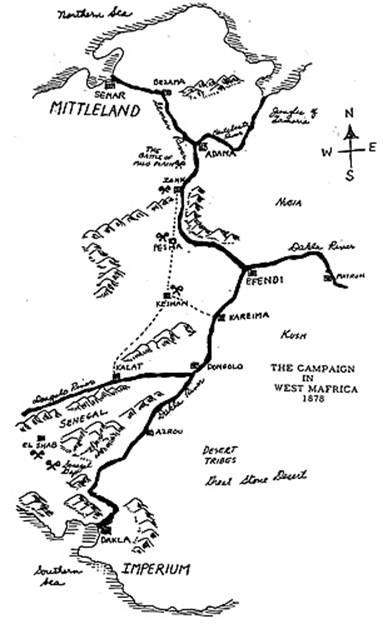This article originally appeared in: The Miniature Parade, Volume 1, Number III (Spring 1968).
This campaign was fought on Jack Scruby’s mythical continent of Mafrica using his own 25mm 1890 African colonial war game army.
Look for more about Mafrica in future articles…
In early January, 1878, the commander of the Imperium Colonial Field Force, General David Rusk, landed unopposed at DAKLA, the only seaport of the Senegal nation, situated at the outlet of’ the great DAKLA RIVER on the southern coast of Mafrica.
Within a few months the position had been consolidated, colonists and officials had arrived, and Dakla became the first Imperium colony in West Mafrica. It had been determined by the General that the nation of Senegal must be conquered first in order to secure the flanks of his advance to DONGOLO, a strategic native city located at the confluence of the Dakla and Dongolo Rivers. Senegal was a rich and prosperous nation, led by King El Schmer (played by Jack Scruby). Two Imperium Divisions were ordered to march upon the Senegalese capitol, EL SHAB, and the Imperium river fleet escorted them northwards to march through SENEGAL GAP into the interior.
El Schmer appealed to his people and raised two large armies. One was to harass the advance of the Imperium columns, and the other was to protect the capitol. At SENEGAL GAP the Senegalese leader sprang an ambush, catching the marching white troops in a narrow valley from all sides. The Imperium 1st Division fought bravely, but after a bloody battle was annihilated, only a few cavalrymen escaping to warn the 2nd Division, marching some 3 days behind the 1st.
For the first time in Mafrican history, natives had to face the terrible firepower of white regulars, and El Schmer’s first army group was cut to ribbons, even though they had destroyed the hated invaders.
Marching through the bodies of their dead comrades at Senegal Gap, the 2nd Imperium Division vowed to avenge the massacre, and met head on with the Senegal army some 10 miles outside EL SHAB. This time, the white troops formed in an open plain, where they destroyed wave after wave of attacking Senegalese, and before sundown, the entire native army had been destroyed with little loss to the 2nd Division. Senegal lay prostate before the conquerors and General Rusk quickly took over the entire country, and moved his advance forces up the DAKLA RIVER to DONGOLO.
As one can see by the map (which is a parcel of Map 3 available to war gamers) the Dakla River, combined with the Semar River, forms an open road through the heart of West Mafrica. Control of this great waterway opened up the entire interior of this area from coast to coast. DONGOLO, EFENDI AND ADANA were key strategic cities along the great river, and control of these towns meant control of the entire area.
This fact had not escaped the early Mittleland explorers, and when word of the successful conquest of Senegal reached GOTHA (the Mittleland capitol), von Scrubitz, chancellor of the Mittleland Empire, ordered an expeditionary force to be fitted out for colonial action immediately. For SEMAR, located on the outlet of the Semar River on the norther coast, had long been friendly with Mittleland, and it was here that 5 Mittleland divisions of the Colonial Expeditionary Forces landed in April, 1878.
The Mittleland forces, led by General Jack von Scruby, moved swiftly southwards along the Semar River, taking ADANA without a fight, for the Nubians were friendly and wanted protection from the Imperium, who by May had moved northwards and taken EFENDI.
ADANA became the major supply base, with ZONK the forward post of the Mittleland army, and plans were laid to outflank EFENDI and DONGOLO by moving along the great inland caravan trails that paralleled the river system.
The Mittleland battle plan was to move 2 Divisions into Nubia, east of the Semar River, cross the Dakla River and capture MATRUH, outflanking EFENDI from the east. Three Divisions were to move through PESHA, KESHAN and KALAT, outflanking the Imperium positions to the West.
Word of this movement reached General Rusk at EFENDI, and he immediately marched a column westward to KESHAN to counter this thrust. The Ist Mittleland Division no sooner arrived at KESFAN, than a battle began, and the advance to KALAT was halted as the Imperium troops massed along the KAREIMA-KESHAN trail ready to hurl back the Mittleland threat. Meantime, also, at MATRUH, the 5th Imperium Division dug in and the Mittleland divisions were unable to cross the Dakla, and eventually retired back to ADANA.
Two great battles were fought at KESHAN. In the first action, the 1st Mittleland Division defeated the 3rd Imperium. Division and destroyed it. However before the victors had time to rest, the 4th Imperium division launched an attack over the dead bodies of their comrades, and drove the Mittlelanders from KESHAN.
Following up the hasty retreat of the Mittleland remnants, the 4th Imperium moved against PESHA. At this point, General von Scruby took up a good defensive position in the hills south of KESHAN and his 2nd Mittleland division administered a sharp defeat upon the enemy. Time after time the Imperium troops, now strengthened with a large native contingent, pressed the attack, but could not force the Mittlelanders from their position.
A week later, the fresh 6th Imperial Division arrived upon the scene and began an attack upon the Mittleland troops. (Our campaign rules state that if a Division is defeated in battle, it is retired back to “home base” and cannot after that re-enter the campaign. The victorious Division is reconstituted at full strength and is available to fight again anywhere). After a bitter battle, the Imperium troops took the position and drove-the Mittlelanders out of PESHA.
Both sides now paused for several weeks to contemplate the situation. No doubt about it, the Imperials seemed determined to chase the Mittlelanders back from where they came, and their next attack upon ZONK was to be important. For this was the forward base of the colonial empire of Mittleland, and must be held at all costs.
It was at this battle that the first trenches appeared in the campaign. General von Scruby dug in his left flank entirely, manning it with native riflemen and Askaris, and for hours it held off the entire mounted am of the Imperium division. However, on the right flank, there had not been time to entrench, and a fierce open field battle was fought out. A key hill in this sector was finally taken by the Imperium troops after bloody loss, and they held firm under a tremendous attack by native warriors and Mittleland cavalry to regain it. The right flank was now turned, and at about the same time, the Imperium cavalry, backed by fierce native riflemen, turned the trench system on the left. The remnants of the Mittleland division gallantly fought back to back, but in the end were overwhelmed, and ZONK fell to the Imperium.
Thus, three of the five Mittleland Divisions had been destroyed in five fierce battles. The 7th and 8th Mittleland divisions had been recalled from MATRUH, and now formed the defenses of ADANA, all that was left to the Mittleland effort.
The 7th was ordered south towards Zonk to attempt to recapture that city, but met up with the advancing 5th Imperium Division at Molo Plain, and there a great battle took place in almost flat terrain, with the exception of a large ridge dominating the center to the battleground. The Imperium regulars, 3 battalions strong, backed by their Askari and native warrior contingents, moved to capture the ridge, but the Mittleland troops reached there first, held the ridge throughout the battle despite tremendous assaults, and after a seven hour battle, defeated the Imperium force.
In the meantime, as the casualties of battle became so staggering, both sides sought peace. At Gotha, a truce was signed between the two Empires with ZONK allotted as the northern most outpost to the Imperium, and ADANA allotted as the southern outpost of Mittleland.
It is doubtful if this uneasy peace would last long, for many troopships were noted pouring into both DAKLA and SEMAR, and great expanses of territory lay east and west of the Dakla River open for exploitation. No doubt the future would see many more colonial wars being fought over this rich land of Mafrica!

